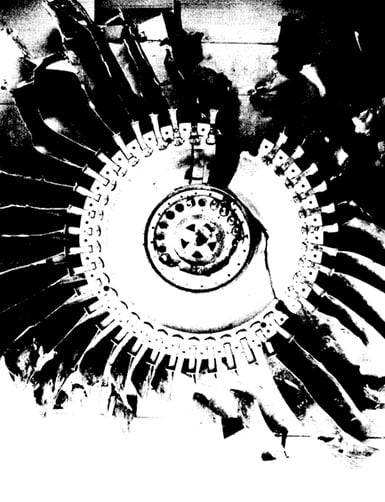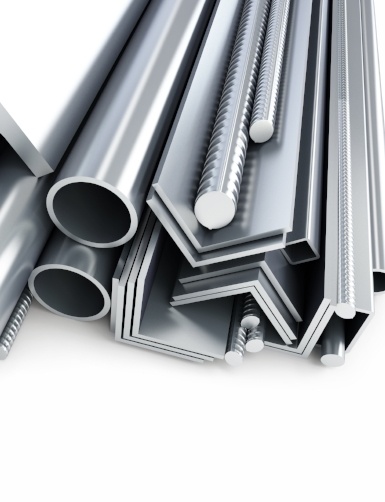Fatigue Life - Part 2
PART II: Mechanics of Materials, Fracture Behavior, and S-N Curves
For materials that fail in fracture, the fatigue failure process is always similar. Firstly, the defect (possibly a surface scratch or pit, or an inclusion of some other material, or nucleation site), begins to grow and becomes a micro-crack due to various factors. After some number of cycles or other insults (mechanical shock, thermal loads, etc), the crack will eventually grow and become a macro-crack. At this point, failure due to fracture is not far behind--the crack at its tip creates a tiny area of very high stress concentration, sometimes 100 to 1000x more than in the bulk material!. This creates a runaway effect in that as the crack grows larger, the stress concentration in the material also increases, causing the crack to grow more and more rapidly.
The reasons and mechanisms for fatigue cracking and failure of metal parts are rather involved, but can be best understood through (1) the behavior of the crystalline structure of various metals and (2) how the stress in materials is affected by geometric features either intentionally designed or due to defects in the part. In either case, the cause of failure will be similar, which is that for some reason, the stress is high enough to break apart the material. Since the behaviors of metals under loading are primarily driven by the atomic crystal structure specific to each metal or alloy, it makes sense to begin with a very basic review of these structures.
Metals and many other materials are formed from repeating structures of atoms held together by ionic or covalent bonds. There are a variety of arrangements that appear in materials, ranging from crystalline systems like those found in metals, cross-linked chains of organic compounds forming plastics, amorphous/random arrangements (as in glass) and so on. Each of these systems of bonding lead to different mechanical properties. For the purpose of this blog, metals are of the most interest since the most commonly applied methods of fatigue design are intended for metallic materials.
At the atomic level, metals and other crystalline materials form a 3-dimensional repeating lattice structure; see the figure below. The majority of metals are either body or face-centered cubic (BCC or FCC) crystal structures. For instance, aluminum is a face-centered cubic material while other materials such as iron and various steels may be either face-centered or body-centered cubic materials. Finally, some metals, most principally titanium, have what is called hexagonal close-packed (HCP) crystalline form.
The main implication of these arrangements is that they lead to varying material properties in varying directions, and that there are some preferential directions in which defects will form and move within this structure.
.png?width=500&name=BESBlog_Fatigue_%20(24).png)
Common Crystallographic Structures for Metals[7]
These defects are created, perhaps only one or a few atoms at a time, by localized stresses within the material. Such stress may be generated by an applied load and are high enough to exceed the yield strength. This causes the atoms to ‘slip’ along these preferential directions, called slip planes. The reasons for this behaviour are complex, but have to do with the geometrical arrangement of the atoms in the lattice and which directions are easiest/preferred for the structure to deform under load. The existence of these slip planes and resulting slip angles has dramatic implications for engineers.
.png?width=512&name=BESBlog_Fatigue_%20(2).png)
Slip Planes for Common Metals[8]
While a detailed understanding of the behavior these slip planes is not greatly important for this blog, it is useful to know that the different arrangements of slip systems are the reason why HCP metals, such as titanium and magnesium are relatively so much lighter and stronger than steel or aluminum (it is also why they are harder to work with). This is because the number of slip directions and systems is very limited in the HCP arrangement vs. the cubic systems. Defects (a discontinuity in the regular lattice) that are created in the crystalline structure either from formation of the crystals or due to applied forces will ‘slip’ along these planes until encountering other defects, at which point they will converge, and may begin to propagate along a different slip plane.
Again, the details of why and how this happens are complex and beyond the needs of this post, but suffice it to say that these defects are important because they are essentially the source of the cracks which drive fatigue-related failure in metals. It is also further important to understand that even though the slip systems are a microscopic phenomenon, they have a very clear effect on the way the metal behaves when subjected to loading. The force applied to the crystal system will concentrate along these shear directions until the local critical stress along one of them exceeds the material yield strength, at which point the crystal system will ‘slip’ along the slip plane and a permanent deformation occurs in the crystal structure. This slippage will accumulate into bands of dislocations lying in the critical slip plane.
The reason for our interest in the crystallographic arrangements of a material come down to how it forms into a bulk solid. Metals are nearly always synthesized from raw material by melting at high temperature and then re-solidifying them by cooling. This re-solidification process involves the formation of crystal grains of various sizes and overall shape, which is determined by the elements (or impurities) present, rate of cooling, etc. These grains form and agglomerate in a similar fashion to concrete, with varying sizes of larger solid pieces aggregated within a binding matrix of smaller particles. The result is a rather random assortment of grains, each a single crystal with boundaries to neighboring grains, as shown below for a low-carbon steel sample.
.png?width=512&name=BESBlog_Fatigue_%20(3).png)
Crystal grain structure in slow-cooled low-carbon steel[10]
Failure-inducing cracks nearly always start on the surface of a crystal grain, because the energy holding the system together is lowest there. Furthermore, any discontinuity in the grain surface, such as a step in the surface structure, is where the localized stresses will become particularly high and activate a slip system. Generally speaking, materials with larger grain systems will often initiate and propagate cracks more readily than will those with finer microstructures. Larger crystal grains will build higher localized stresses and allow defects to propagate along the grain surface for longer distances, creating larger microcracks. A final, very important note is that grains on the physical surface of the part are particularly vulnerable to defect formation because their surfaces are unsupported by surrounding grains.
.png?width=468&name=BESBlog_Fatigue_%20(4).png)
Diagram of bulk Slip behavior in metals[9]
Since the system slips most easily at the surface of grains and of the part, this slipping occurs first on the surface in areas of highest general stress and any stress concentrations due to the part geometry, loading, surface finish, etc. As the part deforms plastically due to this slippage, the material deforms in bands to accommodate the movement along the slip planes. The surface discontinuity caused by this slippage and movement is a common place for fatigue micro-cracks to begin. In parts experiencing cyclic loading, these slip deformations pile up relatively rapidly and generate a rough surface prone to formation of cracks. This is shown below, but can be seen as surface dulling, as when a paperclip is bent back and forth repeatedly.
.png?width=512&name=BESBlog_Fatigue_%20(5).png)
Atomic planes: Surface dislocations and slippage due to monotonic (non-alternating) and cyclic loading[8]
.png?width=512&name=BESBlog_Fatigue_%20(6).png)
Diagram and photomicrograph of slip bands[8]
.png?width=512&name=BESBlog_Fatigue_%20(7).png)
Typical micro-crack initiation sites[8]
Crack nucleation derived from surface slip dislocations are but one of several important sources of fatigue cracks. The other two most common are typically internal defects in the material, either as an inclusion of foreign material or a crack due to a gap in the grain boundary surface contact (shown above). The presence of inclusions may be either from improper alloying or heat treatment of the material, causing precipitation of other metallic phases which force cracks and defects into the surrounding pure material, or from chemical reactions (usually oxidation/corrosion) which disrupt the microstructure by adding oxides or other contaminants. Grain boundary cracks can occur for a variety of reasons as well, but are most commonly due to uneven cooling in the material or thermal stresses in use, or from a defect present in a neighboring grain.
The final microstructural detail that we should consider for this post is how the slip bands and defect accumulations transition from a micro-crack to a macro one. Generally, a nucleation site will cause a micro-crack which spreads along multiple slip bands inside a single grain, until the grain boundary is reached. At this point, a joining defect must be created in the next grain or it must propagate through the boundary. Further cycling causes the crack to grow further until a long crack forms, as shown below.
.png?width=512&name=BESBlog_Fatigue_%20(8).png)
Micro-to-macro crack growth process[8]
.png?width=512&name=BESBlog_Fatigue_%20(9).png)
Photomicrograph of metallic fracture surfaces with characteristic striations[8]
Once a crack has been converted from a micro crack to a ‘long crack,’ the crack will travel and grow each time the critical applied stress exceeds the local material strength, forming additional micro-cracks which then add to the parent defect. This proceeds in a visible set of stages (frequently called ‘beach’ marks) across the part, until the fracture is so large that it exceeds the critical size/stress intensity and propagates through the remaining material immediately. This is your classic, sudden fatigue failure and can be visualized both in photo-microscopy (above) and to the naked eye as very different surface appearances in the fracture zone. The individual steps of crack propagation can be seen clearly below, and can be used to determine the stress and vibration levels which caused a particular crack to form.
An interesting consequence of the combination of slip-plane driven deformations and crack propagation along those directions is that we can see this in parts which have failed in fatigue. For example, drive-shafts and bolts which break due to overloading or fatigue almost ALWAYS have a diagonal/spiral aspect to the crack which causes the part to fail because of the atom-level slip behavior. Furthermore, it is often possible to see with the naked eye the area where the original crack grew via accumulated fatigue damage. One can often see exactly where the crack tip and associated stress concentration exceeded the bulk material strength, immediately breaking the part. See below for an example of a torsion-fatigue failure with a surface-initiated crack.
.png?width=512&name=BESBlog_Fatigue_%20(10).png)
Torsion-fatigue failure of steel samples w/ clear fracture surfaces[11]
Design for Fatigue Life: S-N Curves and Defect-driven reductions in Strength
This all leads us to a second important material property used for ductile metals and the like, known as fatigue performance and characterized by the S-N curve. This curve describes the maximum permissible stress vs. number of expected loading cycles for a material. An S-N curve for a common high-strength steel, 4340 is shown below for room-temperature conditions. Curves for both a relatively perfect specimen and one with a transverse notch cut into the specimen are shown. As one would expect, the effective strength of the material is dramatically affected by the presence of a surface-level defect. Furthermore, the material may lose significant strength at higher or lower temperatures or cycle counts. For example, at higher temperatures, additional slip systems and planes may become active, allowing more options for defect formation and movement/crack growth.
.png?width=512&name=BESBlog_Fatigue_%20(11).png)
S-N Curve for 4340 Steel, Ideal vs. Notched Conditions[2]
As mentioned in detail above, the details of the microstructure dictate the fatigue life and crack growth behavior of a part under repeated loading. The unfortunate reality is that even if we were to start with a nearly perfect material and part, the behaviors of the microstructure are such that some amount of micro-cracking will occur nearly immediately upon application of any load whatsoever. The majority of our fatigue life and reduction of strength is due to the increasing presence of many micro-fractures in areas of stress concentration. The plot below shows the progression of crack propagation and associated strength reductions for 2024 aluminum, a common alloy.
.png?width=512&name=BESBlog_Fatigue_%20(12).png)
Stress vs. Number of cycles for slip initiation, micro-cracking, and progression to failure of 2024 aluminum[8]
For 2024 aluminum, the initiation of material slippage and defect generation is nearly immediately apparent if applied anywhere near or above the noted fatigue limit, even for a flawless specimen. The majority of our fatigue life is in the zone between the beginning of deformations and the joining of microcracks. Once a deep crack is present due to the joining/co-location of too many micro-cracks, we have little control over the material’s fate - the part will fail suddenly at some point, but exactly when is difficult to predict.
Another point of high interest to the designer of high-cycle life parts is what we call the fatigue limit, or the applied stress under which a normal part made from a material will not fail due to fatigue at a given life. For some materials, such as steel, the cycle limit may be considered indefinite as long as the applied load is under the fatigue limit. Of course the value is very specific to the material and application conditions. For aluminum, this is NOT the case--it will eventually fail even under minor cyclic loading. Furthermore, for steels, the indefinite cycle material strength does not apply when extremely high cycle counts (billions) are considered, as the microstructural damage shifts from surface crack nucleation to failures inside the material after hundreds of millions of cycles.
.png?width=512&name=BESBlog_Fatigue_%20(13).png)
S-N curve for SUJ2 bearing steel in bending fatigue[8]
The figures below show in detail the failure origin and progression of steel failure in bending with a surface vs. internal defect. The surface defect causes failure due to fatigue at 259,000 cycles vs. 575 million for a similar defect present inside the part (fish-eye failure). This leads us to believe that if we can start with a part with a good microstructure and few surface defects, the ideal S-N curve behavior can be expected. However, if that is not the case, we must make some allowances for this in the S-N curve we use.
.png?width=428&name=BESBlog_Fatigue_%20(14).png)
Photo-micrographs of SUJ2 bearing steel failure surfaces[8]
The S-N curve is also modified by whether the material is under tensile (like pulling on a rope) or compressive (like sitting on a chair) loading. Most metallic materials are much stronger in compression fatigue than in tensile fatigue loading, as shown below.
.png?width=512&name=BESBlog_Fatigue_%20(15).png)
S-N Curve for material in compression vs. tension dominated loading[8]
Since this is a fairly large amount of information to digest from a single blog post, we’ll present a summary of the major factors influencing fatigue life of metal parts below:
- Number of cycles and magnitude of force applied in the expected life of the part
- The type of loading present (tensile, compressive, fully reversing vs. not, shock/vibration, etc.)
- The geometry and manufacturing of the part (controls stress concentrations)
- Microstructural details such as a defect-free part
- Surface finish is incredibly important -- avoid features which generate high stress concentrations
- The temperature and corrosion environments can impact and possibly accelerate fatigue failure
Sources:
- Vable, M., 2002, “Mechanics of Materials”, Oxford University Press, New York, NY.
- Boardman, B., 1990, “Fatigue Resistance of Steels”, ASM Handbook, Volume 1: Properties and Selection: Irons, Steels, and High-Performance Alloys, Pp. 673-688.
- “United Airlines Flight 232”, https://en.wikipedia.org/wiki/United_Airlines_Flight_232.
- “de Havilland Comet”, https://en.wikipedia.org/wiki/De_Havilland_Comet.
- “Aloha Airlines Flight 243 Incident, 32 Years Later”, Airways Magazine, https://airwaysmag.com/airlines/32-years-aloha-flight-243-accident/.
- Schütz, W. “A History of Fatigue,” Engineering Fracture Mechanics, vol. 54. No. 2 pp 263-300 (1996).
- https://courses.lumenlearning.com/cheminter/chapter/crystal-structures-of-metals/
- Patin, R., Raju, I., “Metal Fatigue Part 1”, NESC Academy Webcast. https://nescacademy.nasa.gov/review/downloadfile.php?file=MetalFatigueOverview_May22.pptx&id=205&distr=Public
- “Slip geometry: the critical resolved shear stress”, https://www.doitpoms.ac.uk/tlplib/slip/slip_geometry.php
- Bhadeshia, H. K. D. H, “Interpretation of the Microstructure of Steels”, https://www.phase-trans.msm.cam.ac.uk/2008/Steel_Microstructure/SM.html
- “Torsional Fatigue Testing”, https://www.phase-trans.msm.cam.ac.uk/2015/RM2/torsion.html
- By Krelnik - Own work, CC BY-SA 3.0, https://commons.wikimedia.org/w/index.php?curid=8019768
- “Fatigue (material)”, https://en.wikipedia.org/wiki/Fatigue_(material)
- “Forging”, https://en.wikipedia.org/wiki/Forging
- Voorwald H. J. C., Miguel, I.M., and Costa, M.Y.P., “Effects of Electroplated Zinc-Nickel Alloy Coatings on the Fatigue Strength of AISI 4340 High-Strength Steel”, Journal of Materials Engineering and Performance, April 2005, https://www.researchgate.net/publication/225585728
- Shahzad, M., Chaussumier, M., Chieragatti, R., Mabru, C., Razai-Aria, F., “Influence of Anodizing Process on Fatigue Life of Machined Aluminum Alloy”, Procedia Engineering 2 (2010) 1015–1024,
https://www.sciencedirect.com/science/article/pii/S1877705810001116?via%3Dihub
Interested in learning more about Boulder Engineering Studio? Let's chat!
Previous Blog Posts
Fatigue - Part 1 |
304 vs 316 Stainless Steel |

|

|
.svg)







